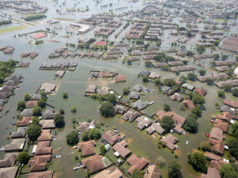A proposal by oil and gas giant EOG Resources to open a sand mine in North Texas’ Cooke County has a small group of nearby families and businesses worried that their health will be put at risk and their water supply seriously depleted if the mine permit is approved.
The sand, predominantly quartz or silica, is prized by natural gas companies for the durability and shape of its grains. The sand is forced, along with water and chemicals, into shale rock formations to fracture the rock and release its natural gas or oil.
But mining the high-grade sand can have serious, even deadly, effects on human health. The federal Occupational Safety and Health Administration lists it as a hazardous and carcinogenic material that can cause lung cancer, silicosis, autoimmune and chronic kidney diseases, and a host of respiratory illnesses.
Residents in the small town of Bulcher, who want the Texas Commission on Environmental Quality to deny the sand mine permit, said potential health hazards are just one category of the mine’s drawbacks. They also are worried about the amount of water the mine will use (3,700 gallons per minute, all day every day, according to the EOG permit request) to clean the sand, the noise from truck traffic, and the potential for mine tailings to get into a creek that runs into the Red River and is the spawning ground for most of the fish in nearby Lake Texoma, a major economic engine for the area.
Mine opponents, who formed a group called Save the Trinity Aquifer, also worry about what the mine will do to their groundwater. Thousands of residents of nearby areas depend on well water. EOG has promised that it will draw from a cache of undrinkable, brackish water hundreds of feet below the Trinity Aquifer that feeds area water wells. The company maintains that the Trinity will not be affected when its operations begin draining millions of gallons of water daily from the deeper aquifer.
Opponents brought their concerns to the TCEQ, which regulates air quality, in an effort to get TCEQ to stall the permit process. A public hearing on the case is scheduled on April 22 and 23 at the Gainesville Civic Center.
EOG, which did not respond to requests for comment from Fort Worth Weekly, says on its website that residents’ fears are groundless. “Over 90 percent of the water to be used at the sand processing facility will be recycled and reused,” says the site. Air quality will not be an issue because “EOG engineers have incorporated state-of-the-art operations systems and emissions control equipment into the sand mine design,” including enclosed conveyor belts and equipment to capture sand dust and other byproducts of the mining operation.
Nonsense, said Ozlem Altiok, a member of Save the Trinity Aquifer. “On paper they’ve got a nice modeling of how this will work, with barely any dust, covered conveyors, and so forth. But this sand is a known carcinogen. And we’re skeptical because EOG is telling us to take their word for it that there won’t be dust escaping. At the same time there will be no air-quality monitoring of the site, so who knows what will be in the air?”
Altiok, who lives roughly two miles from the site, and other Save the Trinity Aquifer members contacted TCEQ officials to ask how air quality concerns about the mine will be addressed if the permit is granted.
“What we heard was very disheartening,” she said. “TCEQ told us that we should report anything we see that’s amiss, to let them know when we see pollution. But you cannot see these particles, so how will we be able to report them?”
According to EOG’s proposed design, the mine and processing plant will occupy 500 acres of EOG’s 1,400-acre property.
When residents heard about the sand mine application in 2011, they began to investigate what a sand mine actually is. Their protests — written complaints, phone calls, and letters to the editor in several newspapers — forced TCEQ to hold public hearings on the permit request concerning air quality, something pretty rare for that agency.
“If we hadn’t raised our voices and stalled the process, that mine would have been in operation since the end of 2011,” Altiok said.
Since the shale gas boom began about a decade ago, similar sand mines have begun operating in several places in Texas and around the country and have drawn regulatory concern. The Minnesota Environmental Quality Board found that such mines “have the potential to generate high concentrations of fine silica dust” that has been linked to a number of lung diseases, but acknowledged that the connection has not been conclusively shown, in part because the onset of diseases can occur long after exposure.
In Texas, TCEQ can regulate air quality at the plant if it chooses to set up a monitoring system, but the agency has no such control over water issues. Under Texas law, surface landowners generally have the right to take as much water as they want from beneath their land, even if they are tapping into aquifers that spread far beyond their property boundaries.
“The EOG plant will wind up using as much water as nearly 54,000 people every year,” said Marc McCord of fracdallas.org, an organization fighting to keep gas drilling out of Dallas. “Now even if they wind up recycling a huge percentage of that, they’re going to be pulling so much water out of the lower aquifer that it might well have an effect on the Trinity Aquifer, and that would be disastrous.”
An EOG spokesperson said at an earlier public hearing that the company had hired a hydrologist who studied the lower aquifer and concluded that water withdrawals by the mining operation might even help recharge the Trinity.
The hydrologist, Dr. Hughbert Collier from Collier Consulting in Stephenville, told the Weekly he was not at liberty to talk about that ongoing study.
Wylie Harris owns 280 acres near the EOG site. He’s worried about what the sand dust would do to his grass-fed cattle and how the EOG water use would affect everyone in the region.
“If the study is not finished, how do they know the Trinity aquifer would be enhanced?” he said.
McCord, a professional fishing guide, said the mine poses a direct threat to the recreational fishing industry at Lake Texoma because of potential damage to Mountain Creek, which runs near the proposed mine and empties into the Red River just above the lake.
Holly Harris-Bayer, vice president of marketing for the Red River Motorcycle Trails off-road vehicle and camping park that adjoins the EOG site, is also fighting the mine permit. The park has been operating since 1972, making it one of the oldest off-road parks in the state.
“Our facility is a great place for families, for camping under the stars, for a great experience you cannot have in the city. But with this facility set to operate 24 hours a day, 365 days a year, the truck noise, truck traffic, and potential for harmful things being released into the air — well, that could certainly compromise the value of the experience people have at our park,” she said.
The protests by the Red River off-road operators and others have led to further public discussion of the proposed mine and could affect the Commission’s decision on the permit.
According to Penny Jordan, a member of Save the Trinity Aquifer, Red River operators convinced TCEQ that the off-road park would be materially affected by the EOG mine. TCEQ then called for the issue to be heard by an administrative law judge — that’s the hearing set for Monday and Tuesday in Gainesville.
The judge is expected to make a recommendation to the Commission to grant or deny the EOG permit as submitted or to grant it with changes. The commission will rule on the permit, which can then be appealed by either side.












